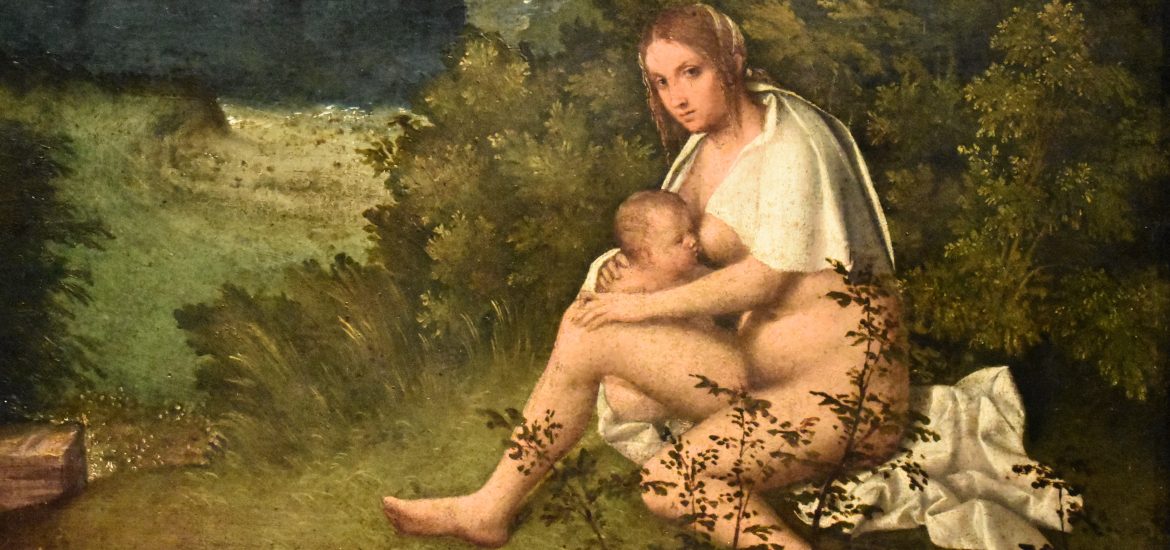On 3rd December 2017, I visited the Gallerie dell’Accademia in Venice for the first time, during which unfortunately an extensive restoration was being carried out. The project, which aims at reinforcing, renovating and refurbishing the first floor of the museum, started on 7th June 2017 and will last for 960 days. It will be divided into four stages to ensure the opening of most of the museum rooms.
I wrote a post afterwards dedicated to that visit focusing on important information such as the gallery’s opening hours, ticket prices, audio guide and guided tours, and floor plan, practical tips, an introduction to the masterpieces which were exhibited at that time, and the then temporary exhibition called “Canova, Hayez, Cicognara. The last of Venice’s final glories”. If you are interested, please click here to have a look. On 26th April 2019, I visited the gallery again mainly for the temporary exhibition called “Leonardo da Vinci. The man model of the world” (Leonardo da Vinci. L’uomo modello del mondo), which was held from 17th April to 14th July 2019 in memory of the 500th anniversary of Leonardo da Vinci’s death. The highlight was undoubtedly Leonardo’s “Vitruvian Man”, which is iconic and among the artist’s best known works, along with “The Last Supper” and “Mona Lisa”. Though belonging to the permanent collection of the gallery, it is rarely shown to the pubic due to its fragility. I read from BBC News that in 2013 it was displayed to the public for a few months and before that it hadn’t been seen by the public for 30 years! What’s more, I saw preparatory drawings for some paintings such as the studies for the famous “Battle of Anghiari” and for “The Virgin and Child with St. Anne”. To read more about the exhibition please click here.
This time I saw some more of the gallery’s masterpieces which were not shown during my first visit due to the restoration project mentioned above. They include The Tempest by Giorgione, the Procession in St. Mark’s Square and the Miracle of the Cross at the Bridge of S. Lorenzo by Gentile Bellini, and the Miracle of the Cross at the Ponte di Rialto by Vittore Carpaccio.
1. The Tempest by Giorgione (1506 – 1508)


Giorgione was an Italian painter of the Venetian school in the High Renaissance, whose career was ended by his death at a little over 30. He is known for the elusive poetic quality of his work, though only about six surviving paintings are affirmatively acknowledged to be his. Before him, the leading painter in Venice had been Giovanni Bellini, who together with Giorgione is regarded as the founder of the Venetian school (of painting). Giorgione set the foundation for the great masters in Venice in the 16th century, in particular Titian, and the uncertainty surrounding the identity and meaning of his work has made him one of the most mysterious figures in European art. I first came to know the artist when I saw his Old Woman also in the Gallerie dell’Academia, who is depicted with shriveled flesh, aged eyelids, toothless mouth, and seems to suggest the fading of beauty over the years. Honestly, the portrait isn’t big and I wouldn’t called the sitter attractive, but it just had some kind of magical power that caught my attention and made me linger.
The Tempest isn’t huge either and could be ignored easily if you haven’t heard about it or its painter. On the right a woman sits, suckling a baby. She has been described as a “gypsy”, and in Italy, the painting is also known as La Zingara e il Soldato (The Gypsy woman and the soldier). Her pose is unusual – normally the baby would be held on the mother’s lap; but in this case the baby is positioned at the side of the mother as if Giorgione wanted to expose her pubic area. A man, possibly a soldier, holding a long staff or pike, stands on the left. He smiles and glances to the left, but does not seem to be looking at the woman. Art historians have identified the man alternatively as a soldier, a shepherd, a gypsy, or a member of a club of unmarried men. X-rays of the painting have revealed that in the place of the man, Giorgione originally painted another seated female nude. The painting’s features such as the fantastic lightning bolt, thick clouds and tree leaves anticipate the coming of a storm. The landscape is not merely a backdrop, but considered by many as a notable contribution to early landscape painting.
Unlike Giovanni Bellini, who worked on public as well as private commissions depicting Madonna and Child, Giorgione worked for clients who were seeking a new type of subject. Like this painting, most of his works don’t have a standard iconography or symbolism. Despite considerable discussion by art historians, the meaning of the scene remains elusive. To some it represents the flight into Egypt; to others, a scene from classical mythology or from an ancient Greek pastoral novel. According to the Italian scholar Salvatore Settis, the desert city would represent the Paradise, the two characters being Adam and Eve with their son Cain; the lightning, as in ancient Greek and Hebrew times, would represent God who has just ousted them from Eden.
2. Procession in St. Mark’s Square by Gentile Bellini (ca. 1496)


I first came to know the artist when I saw his huge canvas known as St. Mark Preaching in a Square of Alexandria in Egypt exhibited in the Pinacoteca di Brera in Milan. It was designed for the reception room of the Scuola Grande di San Marco in Venice and occupies a space of more than 26 square meters. The canvas was started by Gentile in 1504 but left incomplete upon the death of the artist in 1507. It passed to his brother Giovanni, as indicated in Gentile’s will, who completed it and made some modifications.
Gentile Bellini came from Venice’s leading family of painters, and at least in the early part of his career was more highly regarded than his younger brother Giovanni Bellini, the reverse of the case today. His father was Jacopo Bellini, a Venetian pioneer in the use of oil paint as an artistic medium and his brother-in-law was Andrea Mantegna. From 1474 he was the official portrait artist for the doges of Venice, and in addition he painted a number of very large subjects with multitudes of figures, which made him one of the greatest living painters in Venice in his time. In 1479, as part of the peace settlement between Venice and the Turks, he was sent to Constantinople by the Venetian government when the Ottoman Sultan Mehmed II requested an artist. His role was not only as a visiting painter, but also as a cultural ambassador for Venice. Thereafter a number of his subjects were set in the east, and he is one of the founders of the Orientalist tradition in western painting.
The painting shown above was commissioned for the Grand Hall of the Scuola Grande di San Giovanni Evangelista. The commission included a total of nine large canvasses by prominent artists of the time such as Bellini, Perugino, and Vittore Carpaccio. The subject of the paintings was to be the miracles of a fragment of the True Cross, which had been donated to the brotherhood by Philippe de Mézières, chancellor of the Kingdom of Cyprus and Jerusalem in 1369, and soon became the object of veneration in the city. The canvas shows an event that took place about 50 years earlier, on 25th April 1444. While the members of the Scuola were processing the fragment through the St. Mark’s Square, Jacopo de’ Salis, a tradesman from Brescia, knelt before the relic in prayer that his dying son might recover. When he returned home, he discovered that the boy was completely well again.
In the foreground, Gentile painted the confraternity in its white robes, processing at the head of the parade. Although the subject of the picture is supposed to be the miracle itself, the Brescian merchant is hardly visible in the crowd. He kneels in a sumptuous red robe, immediately to the right of the last two canopy-bearers. Rather, the subject of the picture might be more accurately described as the procession, with an especial focus on the space of St. Mark’s square and on St Mark’s Basilica itself, with its Byzantine domes and glittering mosaics.
3. Miracle of the Cross at the Bridge of S. Lorenzo by Gentile Bellini (ca. 1500)

Like the Procession in St. Mark’s Square, this canvas is also among the nine large canvasses commissioned for the Grand Hall of the Scuola Grande di San Giovanni Evangelista, all of which survive. They were all executed in 1496 – 1501, and except that by Perugino, are all now in the Gallerie dell’Accademia. The work portrays a miracle which took place during one of the yearly processions of the True Cross of the Scuola. The relic fell in the water, and subsequently escaped all the attempts of people to catch it, aside from that of Andrea Vendramin, the Gran Guardiano (Grand Guardian) of the Scuola. At the centre of the scene is the Bridge of San Lorenzo, full of people who are looking at the event. The roads which flank the canal are also crowded, with some people coming on gondolas. Some people have dived and a woman, on the right, is pushing her moorish slave to do the same. However, Andrea Vendramin has already grabbed the relic and is carrying it to the shore.
The painting shows a detailed depiction of the canal and the bridge near which the reported miracle occurred, and of a number of people witnessing it. The recognizable characters include Caterina Cornaro, queen of Cyprus, who is the first woman on the left (standing, with a girl to her left). She is praying. The group of gentlemen perhaps depicts Bellini’s family, including his self-portrait and the portrait of his brother Giovanni.
4. Miracle of the Relic of the Cross at the Ponte di Rialto by Vittore Carpaccio (ca. 1496)


Vittore Carpaccio was an Italian painter of the Venetian school, who studied under Gentile Bellini. His style was somewhat conservative, showing little influence from the Humanist trends that transformed Italian Renaissance painting during his time. I saw quite some of his works in Venice and in the Pinacoteca di Brera in Milan, which prove he had no shortage of commissions, but at the same time somehow felt that by comparison with other Venetian contemporaries such as Giovanni Bellini or Giorgione, his art has been rather neglected.
Like the two paintings mentioned above, this canvas is also among the nine large canvasses commissioned for the Grand Hall of the Scuola Grande di San Giovanni Evangelista. It shows the miracle of the healing of a madman through the relic of the Holy Cross, held by the Patriarch of Grado Francesco Querini, which took place in the Palazzo a San Silvestro on the Canal Grande, near the Rialto Bridge. The scene has an asymmetrical composition, with figures in the foreground at the left and, behind them, the façade of the buildings following the canal. They feature the typical inverted cone chimneys of medieval Venice.
One of the reasons why I like this painting is that it gives an impression of the late 15th-century Venice. The Rialto Bridge is still in wood, as it was before it collapsed in 1524. It had a double row of shops at the sides like the current version, and, at the top, a movable boardwalk needed to allow the passage of taller vessels. On the right is the 15th-century appearance of the Fondaco dei Tedeschi, destroyed by a fire in 1505. Other architectural features include the bell tower of San Giovanni Crisostomo, the portico of Ca’ da Mosto and the bell tower of Santi Apostoli before its reconstruction in the late 17th century. Details of human activities include the private gondolas used as ferries, the presence of numerous foreigners with eastern style garments, women clearing carpets, and workers who are clearing their barrels.
Sadly I still haven’t seen Tintoretto’s Miracle of the Slave or Paolo Veronese’s Feast in the House of Levy, which I guess I’ll leave for the third visit to the Galleria dell’Academia.



